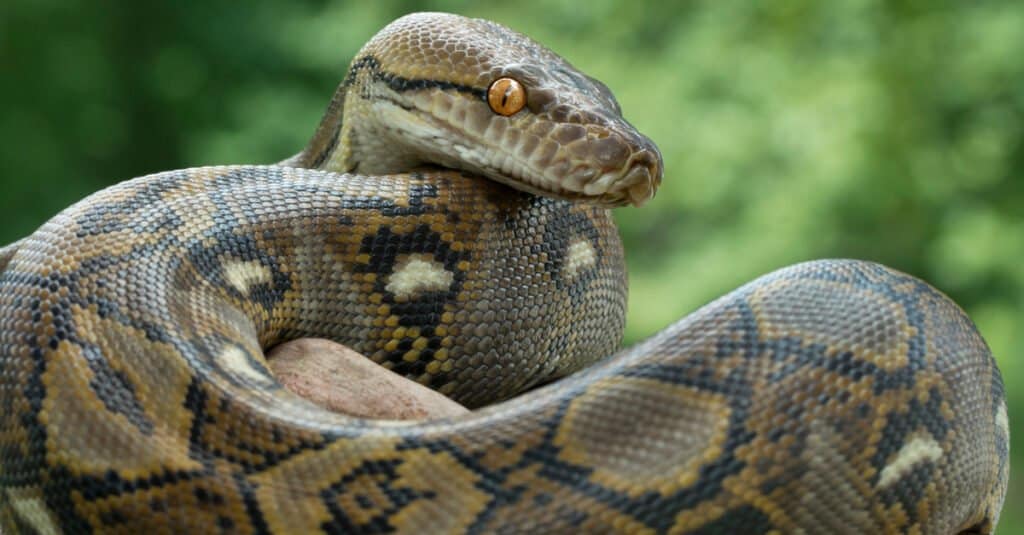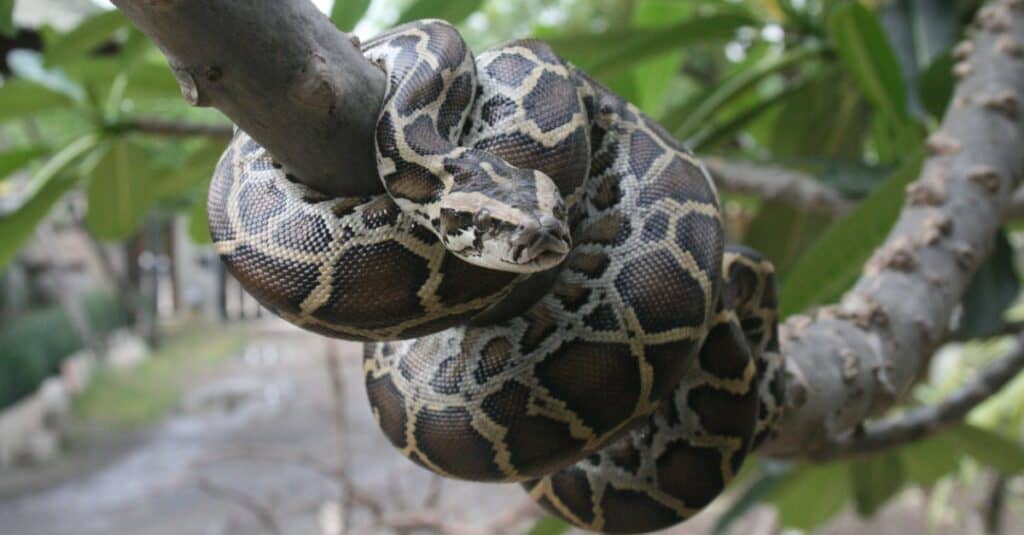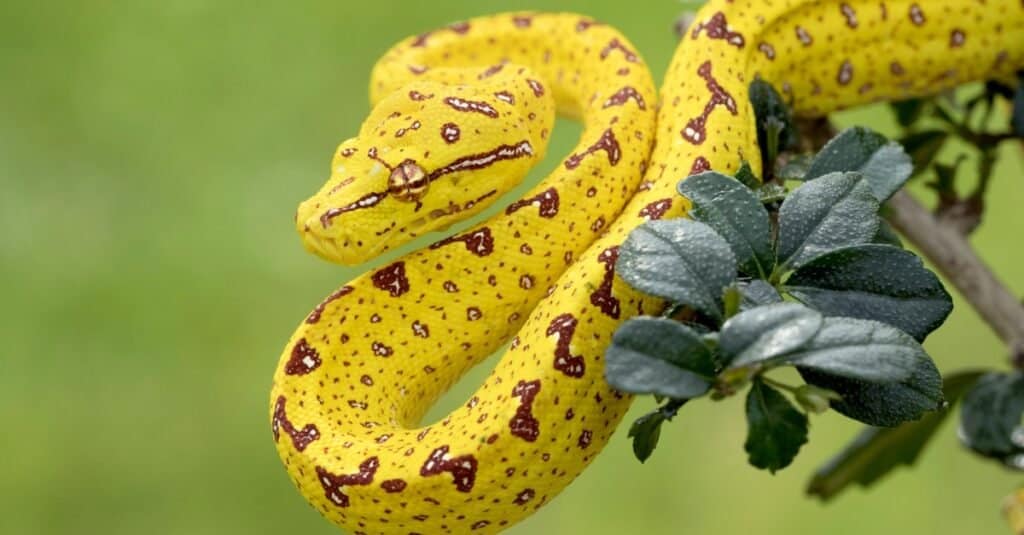Pythons are nonvenomous snakes that can be found in Asia, Africa, Oceana, and Australia, where the majority of climates are warm and wet. Many python species can be found in rainforests, but they can also be found in grasslands, woodlands, swamps, rocky outcrops, dunes, and shrubs, among other habitats. There are 41 species of python that can be found in the family, Pythonidae.
Pythons are typically used as the villains or monsters in movies, as they are notorious for being carnivorous reptiles with a voracious appetite. Pythons obviously sit way up in the food chain, as they feed on other animals, which leaves us the question: What do pythons eat?
What Do Pythons Eat?

As ambush hunters, pythons eat a diet that includes lizards, monkeys, deer and other mammals.
©Mark_Kostich/Shutterstock.com
Pythons eat vertebrates, such as lizards and snakes. They are primarily ambush predators and will consume a wide variety of prey.
The majority of a small python’s diet consists mainly of lizards, which account for the majority of its weight. While growing in size, the python begins to rely more on mammals for food. The diet of pythons can vary depending on the size of the snake, which can range from other reptiles to small mammals.
Here is the list of food pythons like to eat for their primary diet:
- Rodents
- Possums
- Birds
- Lizards
- Monkeys
- Wallabies
- Pigs
- Antelope
- Crocodiles
- Iguanas
- Turtles
- Fish
- Chicken
- Porcupines
- Flying foxes
- Leopards
- Raccoons
- Bobcats
- Deer
- Snakes.
What Do Different Types of Pythons Eat?

The
Burmese
python eats a variety of vertebrates which includes wrens, raccoons, alligators, and bobcats.
©iStock.com/Lunatic_67
Pythons eat depending on their body size, which also depends on the species of the pythons.
Burmese pythons, which have become an invasive species in South Florida, eat a wide range of animals in their diet. As one of the largest pythons they can prey on larger mammals than most snake species. Burmese pythons will eat animals such as:
- Small leopards
- Porcupines
- Flying foxes.
As an invasive species that can reach more than 20 feet in length, Burmese pythons have significantly impacted the Everglades in Florida. Before a massive campaign to eradicate Burmese pythons was conducted, it was found that they had decreased the populations of raccoons by 99.3%, opossums by 98.9%, and bobcats by 87.5%. In the Everglades, Burmese pythons eat the following:
During the early hours of the morning or late at night, Australia’s scrub python will hunt. It is able to see almost anything in dim light because of its large golden eyes. It does not appear to have any adversaries, and it is known to prey on kangaroos and wallabies in the wild. Smaller prey, on the other hand, constitutes the majority of the diet, this includes:
- Rats
- Fruit bats
- Possums
- Chickens
- Pademelon
African rock pythons, on the other hand, consume:
- Rodents
- Antelopes
- Warthogs
- Fruit Bats
- Crocodiles
- Monitor lizards
As you can see, with pythons existing across the world they have a wide variety of animals they eat. However, in every ecosystem they inhabit they have a significant impact as they’re voracious predators, especially to smaller mammals.
How Much Do Pythons Eat?
Pythons do not have to eat very frequently, and once a substantial amount of prey has been swallowed, it is unlikely that it will eat again in the near future. That is to say, pythons are capable of surviving for several weeks without consuming anything.
How Do Pythons Hunt for Their Food?
Pythons are both active during day and night, depending on their prey and habitat. They don’t chase their prey like most snakes. Instead, they hunt and ambush. Pythons hunt for their prey using their sight and sense of smell. Pythons possess a temperature-sensitive “pit” or hole giving them the advantage to track the heat of a nearby animal in order to search for warm-blooded animals in the dark or on dense surfaces.
The python is not venomous. It grabs its prey with its teeth, then wraps and squeezes it with its body coils. But contrary to popular belief, pythons don’t actually crush and dismember their prey. Instead, they suffocate them by tightening their coils each time it exhales. When the prey’s heart stops beating, the python knows it’s safe to let go of its coils and start eating.
Pythons then unfold their jaws and swallows prey whole, usually beginning with the head. The skull’s joints and skin can flex and fold to maximize the mouth’s space, allowing large food items to be swallowed through its esophagus. Constant muscle contractions pull the prey from the snake’s throat and down into its stomach. Pythons’ mouths have special tubes that stay open to take in air, allowing them to breathe while their mouth and esophagus are full.
Do Pythons Eat Humans?

Although rare, a python will only attack a human when provoked.
©Mark_Kostich/Shutterstock.com
Pythons and other snakes have been subjects of many films where they are often portrayed as villains and monsters, eating and attacking humans. However, this is quite unlikely in real life. Most pythons rarely attack humans, and often when it happens, it is because these reptiles were provoked or threatened. In the eighteenth century, however, records show that three of the largest python species launched attacks against humans. Even though African pythons, reticulated pythons and Indian pythons are capable of taking down prey as large as humans, this type of predation is relatively uncommon. Considering that a reticulated python can grow into its maximum length of 30 feet long, it can open its mouth wide enough to swallow a human’s head, but perhaps not enough to consume the whole body.
According to an article published in the Proceedings of the National Academy of Sciences of the United States of America, a few reports of the large reticulated python attacking humans have been received.
What Do Pythons Eat as Pets?
As pets, pythons eat a carnivorous diet that’s heavy in prey like mice and rats. While pythons eat live prey in nature, pet snakes can eat recently deceased meals. For example, mice that were frozen (and properly thawed) often form the foundation of a pet python’s diet.
Ball pythons are the most common python that’s kept as a pet. In the wild, ball pythons prey on rats, mice, and birds, making them relevant pest controllers in Africa. Ball pythons make excellent pets as they feed on rodents and are content to eat either live or pre-killed prey, as long as they are small enough to be swallowed.
If you have a ball python as a pet, here are the list of foods that these carnivorous reptiles love to eat:
- Rodents
- Birds
- Grass Mice
- Black Rats
- Giant Rats
- Weaver Birds
- Rufous-nosed Rats
- Domestic Rats
- Chicken
- Quail
- Young Rabbit.
It is not necessary to feed a ball python on a daily basis. In general, smaller or younger ball pythons require feedings once a week, whereas larger ones require feedings roughly once a month.
Summary of What Pythons Eat
A python’s diet will vary depending on the type and size of the snake. Here’s a recap of the foods that different types of pythons commonly consume. Firstly, this is what pythons in general eat:
| Number | Food |
|---|---|
| 1 | Rodents |
| 2 | Possums |
| 3 | Birds |
| 4 | Lizards |
| 5 | Monkeys |
| 6 | Wallabies |
| 7 | Pigs |
| 8 | Antelope |
| 9 | Crocodiles |
| 10 | Iguanas |
| 11 | Turtles |
| 12 | Fish |
| 13 | Chicken |
| 14 | Porcupines |
| 15 | Flying foxes |
| 16 | Leopards |
| 17 | Raccoons |
| 18 | Bobcats |
| 19 | Deer |
| 20 | Snakes |
Secondly, a look back at what Burmese pythons include in their diets:
| Number | Food |
|---|---|
| 1 | Small leopards |
| 2 | Porcupines |
| 3 | Flying foxes |
| 4 | Herons |
| 5 | Deer |
| 6 | Bobcats |
| 7 | Wrens |
| 8 | Raccoons |
| 9 | Egrets |
| 10 | Alligators |
Next, a reminder of what Australia’s scrub pythons make a meal out of:
| Number | Food |
|---|---|
| 1 | Kangaroos |
| 2 | Wallabies |
| 3 | Rats |
| 4 | Fruit bats |
| 5 | Possums |
| 6 | Chickens |
| 7 | Pademelon |
Finally, here’s what African rock pythons typically eat:
| Number | Food |
|---|---|
| 1 | Rodents |
| 2 | Antelopes |
| 3 | Warthogs |
| 4 | Fruit bats |
| 5 | Crocodiles |
| 6 | Monitor lizards |
The photo featured at the top of this post is © IanRedding/Shutterstock.com
Discover the "Monster" Snake 5X Bigger than an Anaconda
Every day A-Z Animals sends out some of the most incredible facts in the world from our free newsletter. Want to discover the 10 most beautiful snakes in the world, a "snake island" where you're never more than 3 feet from danger, or a "monster" snake 5X larger than an anaconda? Then sign up right now and you'll start receiving our daily newsletter absolutely free.
Thank you for reading! Have some feedback for us? Contact the AZ Animals editorial team.






